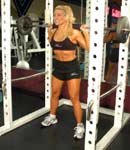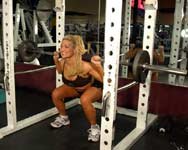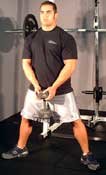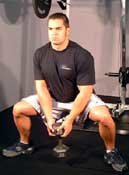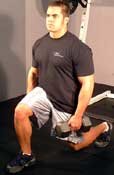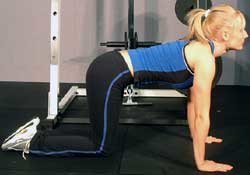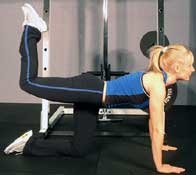If there's a body part that every woman wants to know how to firm and tone, it's the glutes. This butt-fetish has even worked its way into men's fitness.
If a male bodybuilder shows up to a competition with less than chiseled glutes, he's inevitably going to be labeled "soft" and marked down accordingly. So let's discuss exactly how to go about achieving a derriere that you could bounce a quarter off of.
Gluteal Toning
To begin with, let's look at the concept of toning. In actuality, we really misuse the word tone when using it to describe how we want a body part to appear. What we really mean is that we want to build the muscle(s) in that area and decrease the body fat on top of that area.
More muscle and less body fat are what give the "toned" look. So when speaking of toning the glutes, what we really want to do is develop the gluteal muscles, primarily the gluteus maximus, and simultaneously lose fat on and around the glutes.
Increasing the size of the gluteus maximus will give the butt an appearance of being lifted up and back—what I call the bubble-butt effect.
| "Since the gluteus maximus is not on the side of the body, making this muscle bigger will not make the butt look wider, as many women fear." |
Besides the small glute medius muscle that lies on the sides of and above the hips, the only real tissue on the sides of the butt and hip is fatty tissue. So for a narrow-looking butt and hips, losing fat should be of utmost importance.
And remember, there is no such thing as spot reduction. So no exercise burns fat from a particular area—you can't pick where fat goes on or where it comes off. Resistance training builds muscle and diet and cardio burn fat—period! But I digress.
Getting back to tone aspect. The word tone really refers to the degree of contraction of a given muscle at any given time, even at rest. Tone is really more of a neurological (having to do with the nerves) concept than it is a muscular concept.
If a muscle is toned, it simply means that the nerve pathways to that muscle are efficiently developed and that the muscle offers a good strong contraction precisely when it's supposed to.
No discussion of gluteal tonicity is complete without discussing a phenomenon called Lower Crossed Syndrome (LCS). Considered the "father of Czech rehabilitation" Vladimir Janda identified a commonly occurring malady in which the glutes and abs lack tone, while the lower back and hip flexors are tight.
This results in a vicious cycle of pain/tightness/pain/tightness. To stop this cycle and restore normal biomechanics and tonicity to an area, one must first loosen the tight muscles. For example, trying to restore normal tone to the glute maximus before stretching its antagonist, the hip flexors, will simply not work.
This topic could easily be turned into a short book, but the shortened version is as follows: stretch and increase the flexibility of the lower back and hip flexor muscles along with "toning" the glutes and abdominals. So what is the best way to neurologically tone the glutes? Funny you should ask.
Best Way To Neurologically Tone The Glutes
There are two primary factors needed for neurogenic tone:
- Strong stimulus
- Frequent stimulus
Let me elaborate. Moving a heavier weight with your glutes (or any muscle for that matter) is a stronger stimulus to the muscles and nerves than is moving a lighter weight.
That is a very simple, well-accepted fact among exercise scientists/physiologists. If you're paying attention, you're probably thinking, "but wait, I thought lifting lighter weight for more reps was the way to tone an area."
Well, how should I put this; you're wrong! But don't feel bad; many other people think the same thing. The only truth to that is that repeating the stimulus often (many reps) will help to improve tone. But why not repeat a stronger stimulus more frequently.
Now don't get me wrong; doing a lighter weight for many reps will sure do more for improving tone in the glutes than watching Seinfeld reruns. However, the best way to tone is to perform more sets of a heavier weight for lower reps.
Let's look at an example: which would be a better squat routine (more on exercises in a moment) to improve the tone of the glutes?
- 5 sets of 8 repetitions
- 3 sets of 13 repetitions?
Both routines contain about the same number of reps (40 vs. 39), but routine A will serve as a stronger stimulus to the body.
So if you picked routine A, give yourself a gold star! If you picked B, go sit in the corner with the dunce hat on. Let me reiterate one point before moving on—if you have tight hip flexors, it's going to be next to impossible to really tone your glutes, because they are antagonistic muscle groups.
Since the hip flexors pull the leg and rotate the pelvis forward, while the glutes function to bring them back, both sets of muscles can't simultaneously tight.
| "So tight hip flexors = weak hip extensors (glute maximus). And we don’t want a weak booty, now do we?" |
The Routine
To really tone those glutes up in a hurry try this glute specialization routine. Simply work your other body parts around this routine. Although some of these movements hit the rest of the legs a bit, you still need to add some other exercises for quads, hams, and calves.
The following routine is really just to be added to your regular workout. In other words, don't neglect other body parts. (As with any exercise routine, this program should only be done by healthy individuals who have been cleared by their doctor to engage in an exercise routine of this nature.)
Squats
Deep squats are definitely the king (or queen as I prefer to call it) of glute building exercises. Forget those half-squats that you see so many people doing. If you really want to hit the glutes you must go deep, to the basement so-to-speak, on every repetition.
Going deep places a good stretch on the glutes, which forces them to contract forcefully to extend your hip and put you back in the upright position.
Plie Squats
To perform this specialty squat, simply stand with your feet out a bit wider than your shoulders and pointed out at a 45-degree angle. Grasp a dumbbell on end out in front of you between your legs.
Now just squat as you normally would, making sure to go nice and deep to stretch the glutes and to contract your glutes forcefully at the top.
Lunges
Walking lunges are a close second to barbell squats for overall lower body development. To do the movement, simply grab a pair of dumbbells (try a barbell when you get a bit more advanced) and take a large step forward with your right leg.
While keeping your back straight, bend your knees and go down to a point just short of your left kneecap touching the ground. In this bottom position your right knee should be at about a 90-degree angle. (If your knee is bent more than that and your knee is out ahead of your toes, then you either didn't take a long enough step, you're leaning forward as you lunge, or a combination thereof.)
Now bring your left, trailing leg forward so that it's beside your right. Now repeat the movement with the left leg.
Glute Kickbacks
When people think of training glutes, this is typically the type of exercise they think of due to its isolation on the glutes. Glute kick-backs can be done on a specialty, butt-blaster type machine, or can even be done on a low cable by strapping the cable to your ankle.
When doing any type of kickback, make sure to get a full range of motion by bringing your leg as far forward as you can and then extending your leg back as far as possible. Avoid the temptation to arch your back during the kickback portion??"this will rob your glutes of stimulation and possibly aggravate your lower back.
If you really want to enhance the contraction, externally rotate your hip (twist your leg at the hip so that your foot points out toward the side) as you extend your leg back. Also, make sure to pause for a full second in the contracted position.
The Workout
Monday
- Deep Squats: 5 sets of 8 reps (after two light warm-up sets)
- Glute Kick-backs: 4 sets of 10 reps
 Click here for a printable log of Monday.
Click here for a printable log of Monday.
Wednesday
- Walking Lunges: 3 sets of 10 steps with each leg
- Treadmill Walking on steep incline: 15 mins
 Click here for a printable log of Wednesday.
Click here for a printable log of Wednesday.
Friday
- Glute Kick-backs: 4 sets of 8 reps
- Plie Squats: 4 sets of 12 reps
 Click here for a printable log of Friday.
Click here for a printable log of Friday.

